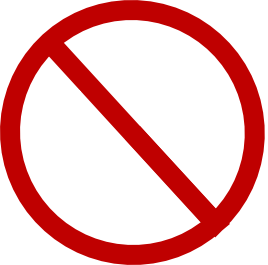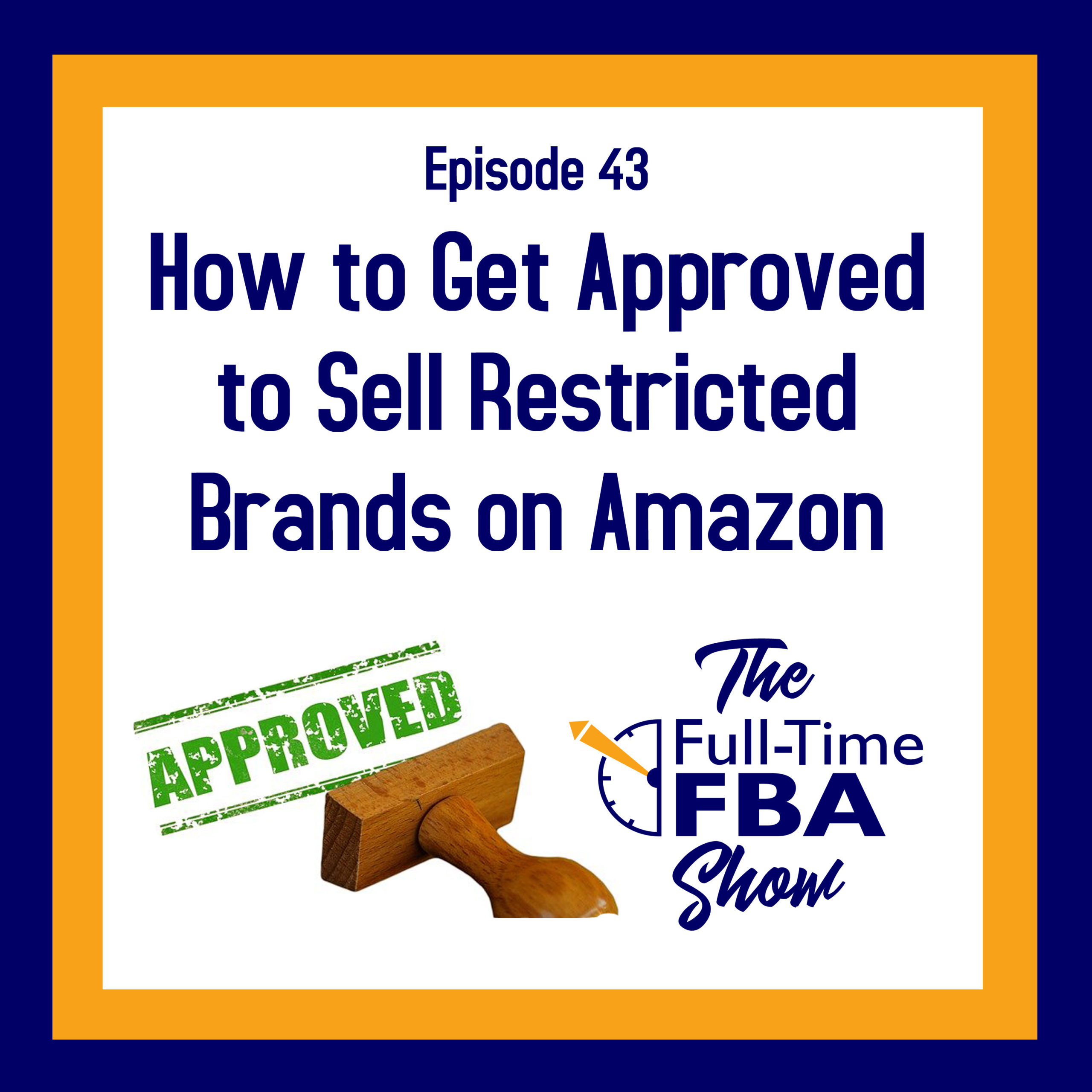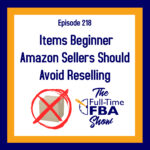When Amazon sellers first get started with their Amazon business, the foremost thing they tend to ask is, “Which items should I sell for a profit?” But an equally important question (and one that is often overlooked) is whether there is anything a new Amazon seller should avoid selling on Amazon — and if so, what?
In today’s episode, we break down which items are more difficult to sell at the beginning stages, what makes these items so challenging, and why you should wait until later in your Amazon journey to take these on. For a full breakdown of everything you should avoid as a beginner (and why), be sure to tune in to this important conversation!
Listen on the podcast player below.
Like what you hear? Tell a friend… and be sure to leave us a rating and a review. Here’s how.
Key points from Episode 218:
 Today’s topic: Items Beginner Amazon Sellers Should Avoid Reselling.
Today’s topic: Items Beginner Amazon Sellers Should Avoid Reselling.- Why you don’t need to avoid these items forever.
- Restrictions Amazon places on new sellers selling certain items in specific categories.
- The challenges of selling electronics on Amazon.
- Why selling clothes and shoes on Amazon is so confusing.
- Understanding expiration dates on Amazon and why selling groceries is not for beginners.
- Examples of seasonal products and why you should steer clear as a first-time seller.
- Why you should avoid products with no sales history.
- Key reasons for not selling products that cost under $12.
- What you can expect from next week’s episode!
Links and resources mentioned in this episode:
 Podcast Episode 043: How to Get Approved to Sell Restricted Brands on Amazon
Podcast Episode 043: How to Get Approved to Sell Restricted Brands on Amazon- Podcast Episode 002: How to Win the Amazon Buy Box for Increased Sales
- Amazon’s pages about understanding expiration dates
- Keepa – Amazon Price & Sales Rank History Tracker
- The Full-Time FBA Coaching Program
Right-click here and save as to download this episode to your computer.
![]()
 THE FULL-TIME FBA
THE FULL-TIME FBA
COACHING PROGRAM
Selling on Amazon might sound easy… but it’s not. Too many Amazon reseller “gurus” will try to get you to fall for an Amazon reseller “get rich quick” scheme, but we’re here to tell you the truth:
- Selling on Amazon is hard, especially when you’re all by yourself… BUT it’s so much easier with a guide — and we’re here to help.
- Selling on Amazon is not a “get rich quick” scheme… BUT it can be a “get rich slowly” plan. With commitment to working hard, combined with our expert guidance, you can start making a full-time income selling on Amazon within about a year.
That’s why you’re invited to join our 12-month long Full-Time FBA Coaching Program. No matter if you’re brand new to selling on Amazon or if you have a few years of experience, our coaching program will take you from where you are to making a full-time income in about 12-months.
We’ve been coaching sellers like you for over a decade and have found what it takes to help you make that full-time income dream into a reality. Find out more about The Full-Time FBA Coaching Program (including how to set up a Connect Call with me to ask your specific questions about the program).
Back to the main page for The Full-Time FBA Show
More Episodes from the Full-Time FBA Show podcast:
Don’t miss an upcoming episode! Subscribe, download episodes, and review the Full-Time FBA Show:
-
-
- Subscribe on iTunes
- Follow on Spotify
- Follow on Amazon Music (or just ask Alexa to “play The Full-Time FBA Show podcast”)
- Follow on iHeartRadio
- Subscribe on Podbean
- Subscribe on Podbay
- Subscribe on Podchaser
-
![]()
Episode 218 Transcript:

[INTRODUCTION]
[0:00:01.8] ANNOUNCER: Welcome to The Full-Time FBA Show. In each episode, it’s our goal to help you turn part-time hours into a full-time income, selling almost anything on Amazon. Now, your hosts of the show, Stephen and Rebecca Smotherman.
[WELCOME]
[0:00:21.3] STEPHEN: Welcome to episode number 218 of The Full-Time FBA Show. Today, we’re talking about items that beginner Amazon sellers should probably avoid reselling, and to talk about with this with me, with you, all this together is my wife, Rebecca. How are you doing Rebecca?
[0:00:37.7] REBECCA: Nice recovery there, I like how you pull.
[0:00:39.7] STEPHEN: Did I recover?
[0:00:40.0] REBECCA: I mean, I think you well did off, well enough.
[0:00:42.2] STEPHEN: Okay, that’s good but yeah, we’re talking about items do Amazon sellers should maybe avoid reselling and we’ll do that on this episode of The Full-Time FBA Show.
[DISCUSSION]
[0:00:53.4] REBECCA: So, when Amazon sellers first get started with their Amazon business, they often wonder first thing, right off the bat, “Okay, what can I sell?” But they don’t really ask the question, “Is there anything I should avoid selling on Amazon?” So today, we’re going to be talking about this topic and we’re going to help you understand that question and how to answer it and let you know about the inventory items that you should stay away from as a beginner Amazon seller, at least for now.
These are not things you would want to avoid forever and we’re not saying that these items are never profitable or that it’s a waste of time to sell them. We’re just telling you that these are items that are more difficult to sell on Amazon and so you should just hold off for now. There are many items you can sell on Amazon that are simpler, they’re easier to sell and in the beginning stages, that’s really the best place for you to start out.
So, once you get some more experience as an Amazon seller, then you can attempt to source these items that we’re going to be talking about in this episode and add them to your inventory.
[0:01:54.2] STEPHEN: Yeah, and just to start off, if you didn’t know, Amazon restricts new sellers from selling certain items and certain categories and so some brands will restrict new sellers from selling their brands on Amazon and we’ve gone deep into that topic of Amazon restrictions in episode number 43. You can check that out at fulltimefba.com/43 and so yes, there are more restrictions for newer Amazon sellers.
But you know, in the episode, episode 43, we talk about ways to increase your chances of getting approved. We’ll even throw some blog links in the show notes, fulltimefba.com/218 because this is episode number 218. So, even though there are some restrictions for newer sellers, there are millions upon millions literally of items that brand-new sellers are allowed to sell on Amazon.
But even if you are allowed or approved to sell an item on Amazon, it doesn’t always mean it’s a good idea to do that as a newbie.
[0:02:48.5] REBECCA: So, for the rest of this episode, we’ll share both general items and then also more specific items that a new Amazon seller should think twice about whether or not they should put their hard-earned sourcing money into buying those items. You would also be spending your time on buying these items and sourcing them to sell on FBA and we just really want you to think about your finite resources of time and money.
So, Stephen, kick us off with the first item that newbies should avoid sourcing to sell on Amazon.
[0:03:19.5] STEPHEN: So, the first thing to avoid as a newbie, again, not all Amazon sellers need to avoid this but new Amazon sellers don’t start off selling electronics. The category of electronics is more than just selling a cellphone or a laptop, or a smart speaker, or anything like that but selling electronics on Amazon could also involve warranty information. You know, is the customer going to be asking you to fulfill the warranty or is the brand going to honor a warranty sold by third-party Amazon sellers?
You just don’t want to be in that situation and so a customer might just assume and it might actually state it on the Amazon product page that they’d get that warranty. Also, most electronic items sold by third-party sellers, they’re used and that’s just an absolute nightmare when it comes to, you know, just checking the product for defects before selling and all that. So, even if you put “not check for defects” in the used condition notes, most customers don’t read those notes and they’ll return the item for the defect or worse, leave you a negative feedback.
I say worse because if negative feedback is worse because a great feedback score is vital to getting an Amazon business going. For the most part, if you have really great feedback you’re going to get more time in the buy box and the buy box is where 80% of all sales come from. We go deep into how the buy box works on episode number two of the podcast, fulltimefba.com/2. I mean that’s how important winning the buy box is, we put it in episode number two.
And so, if you are selling electronics on Amazon as a newbie, you’re just welcoming potential negative feedback and we want you to avoid that.
[0:04:52.7] REBECCA: So, the second thing that we would recommend new sellers avoiding selling on Amazon is clothing and shoes and I say this as someone who sold shoes and clothing for years on Amazon, so I have a lot of experience in these categories. So, when you are starting out as a new Amazon seller, you really want to keep things as simple as possible. Shorten your learning curve, learn the basics, and then move on to more difficult things.
And there’s an aspect of selling clothing and shoes on Amazon that is really, really confusing and this might not be super intuitive if you’re used to selling on eBay or Poshmark but the way listings are done on Amazon can be really confusing to correctly understand and that’s because Amazon has their shoes and clothing organized in their catalog by variations and it can be really confusing.
So, here’s how these variations are organized and how it can be confusing. For most items on Amazon, each inventory item is matched up with an ASIN. An ASIN means, Amazon Standard Identification Number, and it’s basically a 10-digit alphanumeric code that identifies products on Amazon. So, it’s going to be a unique ASIN for each product and it’s assigned when a new product is brought to Amazon.
Most items you’ll sell on Amazon have one ASIN and it’s simple, just the one straightforward ASIN but with clothing and shoes, the Amazon catalog is set up with a parent ASIN for the main product title and then each combination of color, size, style different, so on, will have their own specific child ASIN that’s connected to the parent ASIN. So, imagine a hierarchy of a parent and then all of the children underneath it.
So, to make sense out of what I just explained, think about it this way. Imagine you’re selling a simple Nike golf shirt that has a small Nike logo on the left side of the chest. That basic concept of that golf shirt is going to be assigned to a parent ASIN but that shirt is going to have multiple sizes, small, medium, large, extra-large, and so on. There’s also going to be multiple colors of that shirt that are available, red, blue, orange, green, whatever.
And there’s going to be multiple next styles possibly. You’re going to have V-neck, rounded, collared. You might have multiple types of sleeves, short sleeve, long sleeve, sleeveless. All of these shirts belong in that same overall parent ASIN and they all have the same style of the small Nike logo on the left side but there’s going to be many, many variations. So, one parent ASIN might have over a 100 child ASINS because if you’ve got a small red short sleeve V-neck shirt, it’s going to be one child ASIN but a small red short sleeve collared shirt is going to have a different child ASIN.
[0:07:51.4] STEPHEN: Are you confused yet, listener? Are you confused?
[0:07:53.2] REBECCA: I mean, this always, thinking about child ASINs always takes me back to like middle school math, where you’re like multiplying out how many possibilities are there, really, it goes back to that. So, how does this makes things hard for a new Amazon seller? I mean, it seems like it’s pretty straightforward as far as like matching it up to make sure that you’ve got the right size, style, color, all of that.
But then what makes it difficult is knowing the sales rank for your shoes or clothing that you are trying to sell on Amazon. So your sales rank on these pages that have a parent ASIN and multiple child ASINs, children, I don’t know, child ASINs, childrens, I don’t know. Anyway, the sales rank that is shown on these Amazon pages and therefore shown on any type of device that you’re – an app or a program that you’re using to scan is not going to show you the sales rank for each individual child ASIN.
It’s only going to show you the sales rank for all of those child ASINs combined under that parent ASIN. So, if the Amazon product page says that this Nike golf shirt that we’re talking about. That has the Nike logo on the chest is ranked 10,000 in the overall clothing category, you have no way to know which size, which colors, which sleeves, et cetera, of that shirt are really giving it that sales rank. Which ones are selling well and which ones are not? And you have to know the sales rank of an item before you sell it, right? You cannot blindly list your items, not knowing what the sales rank is. But if you can’t know the sales rank of the child ASIN, you can only know the overall parent ASINs sales rank, how do you make a decision.
That is a perfectly normal question to ask, you should be asking it. And that’s the reason why we don’t think it’s a good idea for newer sellers to sell items with multiple variations on Amazon. You really need to wait until you get some experience and you can understand sales rank, and overall, you can understand how different categories work. And then, you can learn how to bring clarity to variations. Because you can know which ones are going to sell more.
You can better understand, you can make a more educated decision about it, even though you don’t know the exact sales rank of a child ASIN. But that’s an advanced skill. And you want to wait until later on in your Amazon journey to try to learn that.
[0:10:14.9] STEPHEN: Yeah, and this is not even getting into the many possibilities of returns of shoes and clothing because people try it on and return it. So, clothing and shoes, it could be very profitable but it is an advanced strategy that we do not recommend new Amazon sellers focus on. The third type of item that we recommend that newer sellers stay away from, are groceries. Now, groceries can be a really profitable category to sell in.
But we only recommend Amazon sellers get a little more experience under their belt before adding groceries to what they’re selling on Amazon. And the main reason is because, groceries have expiration dates. Amazon has very specific rules on when you can sell items with an expiration date, how much lead time, and grocery item needs to be in the customer’s hands before it’s allowed to be sold.
And so, Amazon updates these rules from time to time so I’m not going to give you the exact amount of lead time and plus it’s different for different types of items but I will give you a link on our show notes page. Fulltimefba.com/218. I’ll put the links to Amazon’s pages about understanding expiration dates if that’s something you want to know. But you know, most items that you can sell on Amazon, they’re just easier, because you can just send your stuff to Amazon and have an indefinite amount of time until it sells.
I mean, of course, your monthly storage fees and things like that. But groceries, you have a literal clock counting down on how much time you have to sell your item before it becomes unsellable. And this is not even considering the times you’re allowed to sell multiple type of groceries on Amazon via FBA. So, when selling groceries, you need to do a good job of keeping track of expiration dates and set reminders and making sure that you sell out before an item becomes unsellable and it’s just the worst to invest sourcing money into a grocery item, and then it never sells, and then the item expires and there’s nothing you can do with it but throw it away. Dispose of it.
That’s just a huge waste of time and money. Again, it can be a really profitable category to sell in, maybe not for new sellers who are learning the basics. But once you get some experience, you can start to add groceries later on in your Amazon journey.
[0:12:18.3] REBECCA: Yeah, don’t ask us how many times we – the beginning stages of selling grocery items on Amazon ended up having to remove items because they’d reached that lead time for expiration date and we ended up having to eat them ourselves.
[0:12:33.0] STEPHEN: Yes, yes.
[0:12:33.8] REBECCA: Which you know, can be delicious but it’s not profitable.
[0:12:37.4] STEPHEN: Absolutely.
[0:12:39.3] REBECCA: All right. So, the fourth group of items that we would recommend you steer clear of as a beginning seller are seasonal products. So, these are the type of items that really are only selling big during the season that they’re associated with. There are some advanced strategies to selling seasonal items out of season that might really work for you but it takes a lot of forethought and a lot of strategy and so, we don’t really recommend if you’re just starting out, putting your sourcing money into an inventory item that has a super short timespan when it’s going to get those big sales.
So, selling seasonal items is almost like selling items with expiration dates because you’ve got a much tighter cutoff time where you’re going to have to call that item back or it’s not going to sell. So, for example, sandals, obviously, sell really well in the spring and summer months when it’s warmer, but they’re not going to sell very fast in the fall or winter or they’re not going to sell at all in the fall or winter.
So you don’t want to start out when you’re first in your Amazon FBA business, focusing on selling sandals and putting a lot of money into something like that, if you don’t know how to sell them quickly. Because you’re going to end up carrying them over into fall and winter when nobody is shopping for sandals. So, don’t focus on selling these types of seasonal items when you first get started. Wait until you’ve got some experience and you can strategize better, how to make those buying decisions.
[0:14:12.9] STEPHEN: Another type of item that we do not recommend new Amazon sellers and actually, most Amazon sellers selling. Are products with no sales history. I mean, we can’t have an episode of the Full Time FBA Show without mentioning Keepa.
[0:14:26.4] REBECCA: I don’t know that that’s ever happened, has it?
[0:14:27.7] STEPHEN: It might not, I don’t think so. I mean, if you don’t know, if you’ve been living under a rock, Keepa is a tool that tracks the sales rank and price history, and tons more, for almost every item on Amazon. You can check it out, fulltimefba.com/keepa.
[0:14:40.1] REBECCA: Hey, can I stop you right there?
[0:14:40.9] STEPHEN: Sure.
[0:14:41.3] REBECCA: I am not a fan of the expression, if you’ve been living under a rock. Because, it just implies that you know, you’re missing out on something you haven’t heard about it. If you’re listening to this and it’s the first time you’re hearing about Keepa, that is okay, there was a day when I did not know what Keepa was and Stephen did. And he told me about it.
[0:15:01.2] STEPHEN: And there was a day when I didn’t know what Keepa was. I apologize, I stand corrected for my phrasing.
[0:15:07.0] REBECCA: I just wanted – I just wanted to make sure, anybody that’s listening to this who is new to selling on Amazon is like, “Well, I have not been living under a rock but what on earth is Keepa” It’s fine. You don’t know about it. But now you do and just wait, you’re going to hear about it from us a lot.
[0:15:19.5] STEPHEN: That’s cool. And I will never probably use “Living under a rock “, phrase again, because you’re right. I don’t want to exclude anybody. But when it comes to buying products on Amazon with no sales history. So, when it comes to focusing on inventory to sell on Amazon, if you come across a product with no sales history, stay away. You know, you might think, “Well, what if it’s new to Amazon? There’s no sales history because it’s new to Amazon” Well, wait until there’s a history of sales data and make a smart sourcing decision based upon the sales history.
But what if it’s a big-name brand and a popular topic or something like that or really cool with the kids or whatever? Then check to see if maybe there’s another product page on Amazon that matches the item better. See if there’s a sales history there. But never buy an item to sell on Amazon that has no sales history, please.
[0:16:04.9] REBECCA: At least, not when you’re getting started.
[0:16:06.0] STEPHEN: Absolutely, right.
[0:16:06.8] REBECCA: And then like Stephen said, very rarely do we do that even as experienced sellers. We are always looking for items that have a really solid sales history.
[0:16:15.3] STEPHEN: Yeah, solid seals history, consistent pricing, those are the things we’re looking for.
[0:16:19.5] REBECCA: All right. So, the last category that we wanted to talk about, that are items we do not recommend selling as a newbie, and actually, this again, is one that I would not sell even as more experienced seller. But products with the selling price under USD12. That’s the very, very lowest cutoff, the floor of that. I would put that even higher than Stephen does. I think we’ve talked about this before, that his floor for the price is lower than mine.
But, this one’s easy. This one, you can keep that in mind that dollar amount, and just understand that there’s no way you’re going to make money if you are selling an item that’s priced lower than USD12. Almost all items sold on Amazon via FBA, that are priced under USD12 are going to leave you no profit. I mean, I’m not saying there’s not items being sold via FBA that are priced lower than USD12. There are. But those people are not making any money on it.
Amazon’s FBA fees are going to take about USD10 total in fees for anything under USD12. So, that’s going to leave you with basically nothing, I mean, you would have had to have received that item for free to make USD2 on it. And that’s just not worth your time to spend on that. Especially as a beginner when you’re needing to grow a profitable business.
[0:17:38.5] STEPHEN: So, those are the things that we recommend new Amazon sellers stay away from when they are first starting outsourcing, trying to grow their Amazon business, and we invite you to join our Full-Time FBA coaching program. If you’re interested in information about it, go to fulltimefba.com/coaching. We’d love for you to join us and we can give you tips and tricks along the way of how to grow your Amazon business.
[0:18:00.4] REBECCA: It is always a good time to find out more information about the Full-Time FBA coaching program. It is never the wrong time to join if you are wanting to get started on being truly successful at growing your FBA business. Please check it out, fulltimefba.com/coaching.
[CLOSING CONVERSATION]
[0:18:19.9] REBECCA: Thank you so much for joining us for this episode of the Full Time FBA Show. As a reminder, the show notes can be found at fulltimefba.com/218, because this is episode number 218.
[0:18:31.5] STEPHEN: And next week on the show, we’re going to talk about items beginning Amazon sellers should focus on reselling. We don’t want to leave you hanging and just give you a whole episode of what to stay away from. Next week, we’re going to talk about the things you should be focusing on to sell on Amazon and we’ll see you there next week on the Full Time FBA Show.
[0:18:49.4] REBECCA: Cliff hanger.
[OUTRO]
[0:18:53.2] ANNOUNCER: That is all for this episode of The Full-Time FBA Show. So head over to fulltimefba.com/podcast, where you will find the show notes and links from this episode. While you’re there, subscribe to our newsletter where you’ll get several free downloads of our popular and helpful Amazon FBA resources. Now, take action on what you have learned today, so you can find success at turning part-time hours into a full-time income with Amazon FBA.
[END]


Leave a Reply